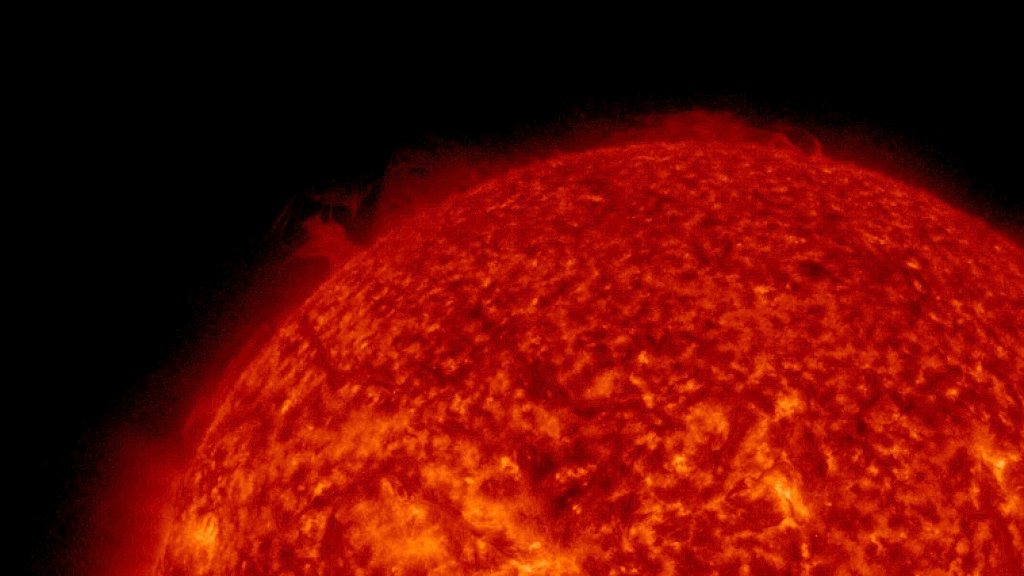Mercury slammed by gargantuan eruption from the sun's hidden far side, possibly triggering 'X-ray auroras'
A gigantic plasma eruption from the sun's hidden far side recently launched a sizable coronal mass ejection that slammed into Mercury, potentially triggering invisible X-ray auroras around the planet's rocky surface.

A gigantic, fiery eruption around 40 times wider than Earth recently exploded from the sun's hidden far side. The eruption hurled a massive cloud of plasma into space that later smashed into Mercury, scouring the planet's rocky surface and potentially triggering "X-ray auroras" on the unprotected world.
The eruption was likely triggered by a powerful solar flare, which occurred around 7 p.m. ET on March 9, Spaceweather.com reported. NASA's Solar Dynamics Observatory (SDO) spotted a large, partially obscured plasma filament exploding outward from behind the sun's northeast limb. Based on the amount of visible plasma, the eruption likely spanned around 310,000 miles (500,000 kilometers) across.
SDO data showed that the explosion, which likely left behind a massive "canyon of fire" on the sun's surface, also released a large coronal mass ejection (CME) — a fast-moving cloud of magnetized plasma and radiation — that collided with Mercury on March 10.
Related: Upcoming solar maximum may help solve the sun's gamma-ray puzzle
Mercury is often blasted with CMEs due to its proximity to our home star. The small planet has no atmosphere left as a result of this bombardment and is fully exposed to the full force of these solar storms.
When electrons from CMEs hit Mercury's unprotected surface, they rapidly slow down. This deceleration causes the particles to release energy in the form of X-rays, which scientists can detect from Earth. The result is an aurora-like phenomenon that is visible in X-rays rather than visible light.
The gigantic eruption is the latest sign that the explosive peak of the sun's roughly 11-year solar cycle, known as solar maximum, may have already begun — much earlier than originally forecast.
Get the Space.com Newsletter
Breaking space news, the latest updates on rocket launches, skywatching events and more!
During solar maximum, solar flares and other types of solar storms erupt more frequently and more powerfully as the sun's magnetic field weakens and eventually flips over. Scientists are already seeing signs of this happening.
In the last month, researchers have seen some of the biggest solar storms of the current cycle, including a monster X-class flare — the most powerful for more than six years — and a plume of plasma 15 times taller than Earth, which erupted from the sun's south pole.
One of the biggest concerns during solar maximum is that researchers can't properly monitor the far side of the sun, which can harbor giant sunspots that unleash surprise solar storms, like the one that just hit Mercury. It's possible that these sunspots could swing round to face Earth as the sun rotates, exposing our planet to flares and CMEs. For example, in January 2023, a hidden sunspot spat out an X-class flare without warning that narrowly avoided Earth.
One secret weapon NASA has up its sleeve to prevent being caught out by these unseen dark patches is the Perseverance rover, which can sometimes spy on the sun's far side from its home on Mars. But this only works when Earth and Mars are located on opposite sides of the sun.
Originally published on LiveScience.com.
Join our Space Forums to keep talking space on the latest missions, night sky and more! And if you have a news tip, correction or comment, let us know at: community@space.com.

Harry is a U.K.-based staff writer at Live Science. He studied Marine Biology at the University of Exeter (Penryn campus) and after graduating started his own blog site "Marine Madness," which he continues to run with other ocean enthusiasts. He is also interested in evolution, climate change, robots, space exploration, environmental conservation and anything that's been fossilized. When not at work he can be found watching sci-fi films, playing old Pokemon games or running (probably slower than he'd like).










